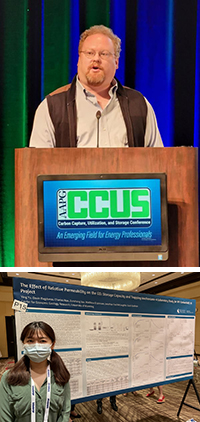
SER Researchers Present to AAPG CCUS Conference in Houston
Published April 18, 2022
By Christine Reed

(top) Matt Johnson addresses the audience at the AAPG CCUS conference. (bottom) Dr.
Ying Yu presents her poster during the poster session.
Members of the School of Energy Resources (SER) research team traveled to Houston, Tex. for the American Association of Petroleum Geologists (AAPG) Carbon Capture, Utilization, and Storage (CCUS) conference March 29-31.
The AAPG CCUS conference brings together skilled petroleum geologists, geophysicists, and engineers dedicated to the future of carbon management. The conference aims to highlight current CCUS work and address related challenges in order to forge a path forward for sustainable energy development.
Among the presenters at the conference was one of the unsung heroes of the Center for Economic Geology Research (CEGR), Matt Johnson.
A native of Huntsville, Tex., Johnson is a geologist that specializes in geologic modeling for CEGR, performing the essential role of converting large data sets into accurate 3D representations of the earth’s crust and subsurface.
Joining UW’s Enhanced Oil Recovery Institute (EORI) in 2005, Johnson completed his B.S. in Geology from UW in 2008. He continued to work for EORI for over a decade performing geologic modeling and petrophysical analysis before coming to the SER in 2018. He is currently pursuing a master’s degree in Geospatial Information Science & Technology (GIST).
Johnson’s ability to depict complex seismic data, geographic information, and other scientific research into visual models characterizing actual project sites has been instrumental in the success of SER-led projects such Wyoming CarbonSAFE Project.
“We could not do what we do without the work that Matt does to provide a detailed map of the subsurface far beyond a stratigraphic column,” says CEGR director, Fred McLaughlin. “We are fortunate to have a vast knowledge of the geology in the state, but we also know that there can be significant changes in lithology within close proximity. Matt’s work provides us with a higher level of certainty of what those layers actual look like across wide distances and how CO2 will likely behave in our target storage formations.”
While at the conference, Johnson’s presentation, Geologic Modeling and Characterization of the Carbon Stacked Storage of the Minnelusa, Hulett, and Lakota of the Dry Fork Station Site in Gillette, Wyoming, kicked off a session dedicated to end-to-end storage technologies for CCS deployment.
“I was very humbled to present our findings to such a large crowd of peers in the CCUS community,” says Johnson. “What I presented is very important in terms of mitigating risk of carbon storage and determining how much CO2 can actually be held in that area. An acute knowledge of the subsurface is also an essential part of meeting the requirements for class VI wells.”
Johnson stresses that public awareness is a main goal in the development of CCUS and building support for the possibilities it has to offer in a low-carbon future.
“The more we know and share on our work, the better,” he says. “We are making the public aware of what is happening in the subsurface through our modeling simulation work, and having access to that information cannot be overstated.”
In addition to informative presentations and technical programs, the emphasis on the conference is to network and make valuable connections with other professionals.
“The conference was a lot of fun,” adds Johnson. “Once I was done presenting I could actually meet with industry experts to discuss issues I’ve encountered, learn what others are doing, or learn news ways to find solutions for shared challenges.”
In addition to Johnson, McLaughlin also presented at the conference, as well as Eugene Holubnyak, SER’s director of the Hydrogen Energy Research Center (H2ERC). SER’s senior director of research Scott Quillinan was also in attendance, along with senior geologist, Zunsheng 'John' Jiao.
Dr. Ying Yu, a CEGR research scientist specializing in unconventional reservoir injection technologies, presented a poster on The Effects of Wettability and Relative Permeability Variations on the CO₂ Injectivity, Storage Capacity, and Trap Mechanism–A Laboratory Study for WY CarbonSAFE III Project.
“Ultimately, conferences like AAPG are about bringing a community together with a common goal to drive new technologies and ideas forward,” adds McLaughlin. “I’m very proud of my team for working towards achieving our goals for CCUS, and believe that what they presented has added significant value to the research of others in this area.”
